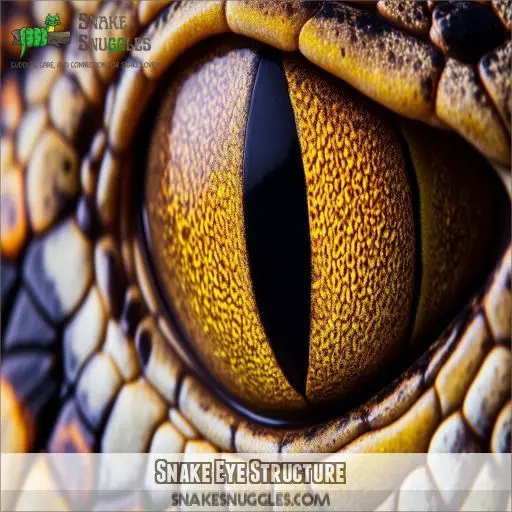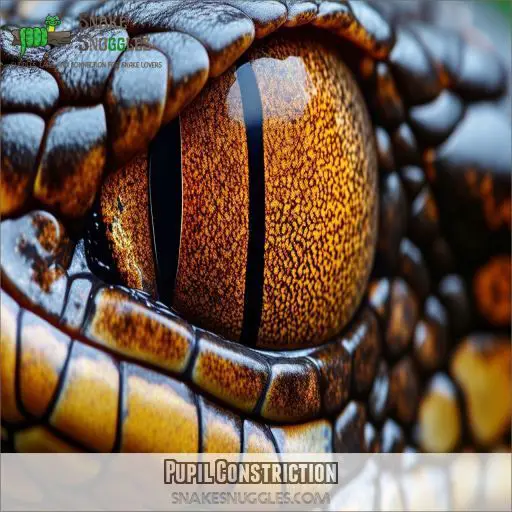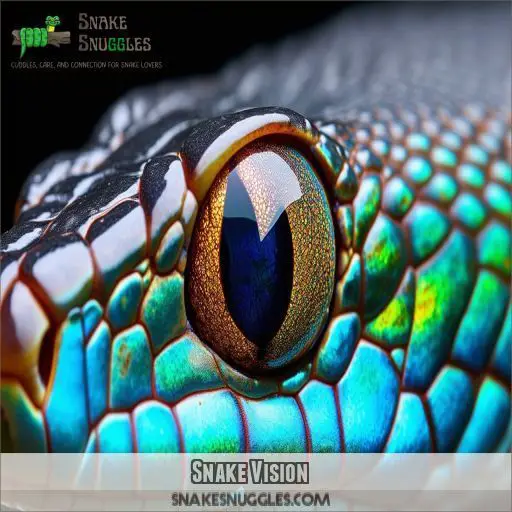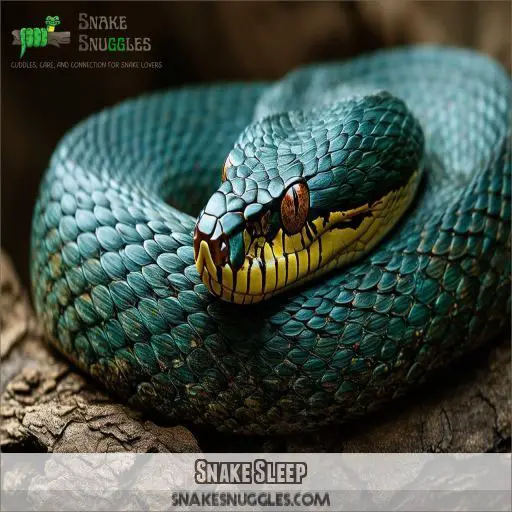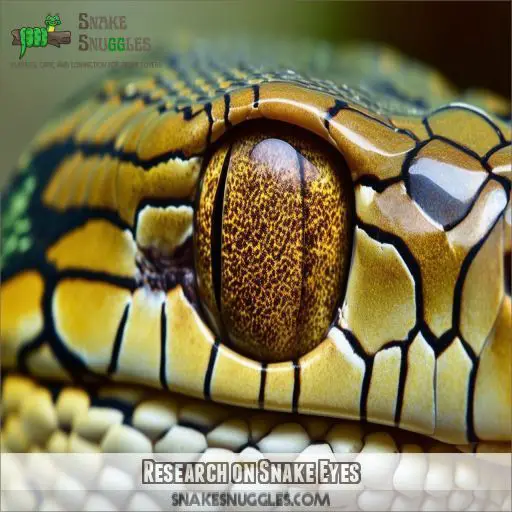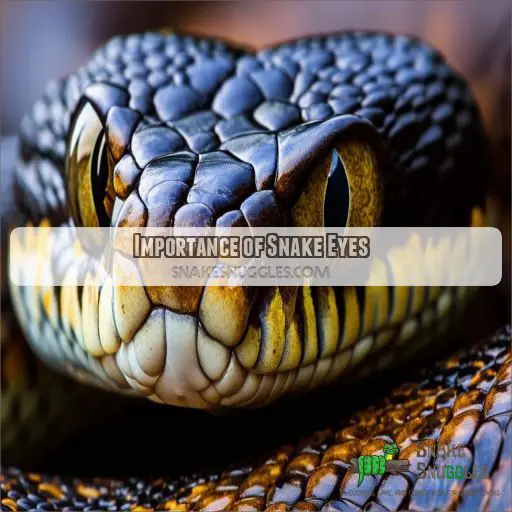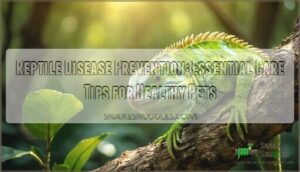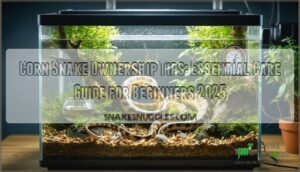This site is supported by our readers. We may earn a commission, at no cost to you, if you purchase through links.
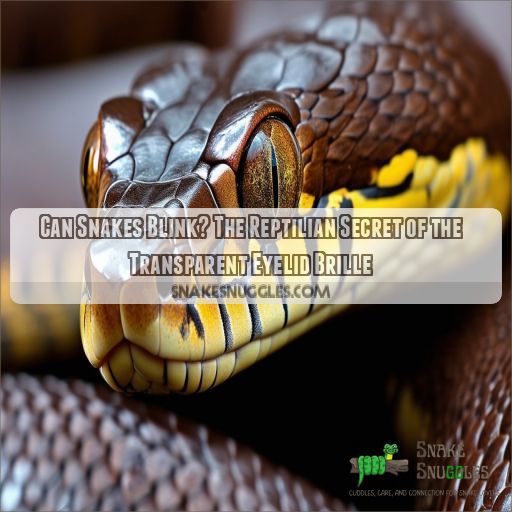 No, snakes can’t blink their remarkable eyes due to their lack of eyelids. Instead, they possess a specialized transparent scale called the brille that acts as a permanent goggle, protecting their eyes while allowing constant vision.
No, snakes can’t blink their remarkable eyes due to their lack of eyelids. Instead, they possess a specialized transparent scale called the brille that acts as a permanent goggle, protecting their eyes while allowing constant vision.
This evolutionary adaptation, inherited from lizard ancestors, filters UV rays and enhances low-light vision through constricted pupils. With a wide field of view and the ability to detect faint movements, the snake’s vision is optimized for its predatory lifestyle.
Want to uncover more secrets behind this reptilian marvel? Then dive deeper into the fascinating world of snake eyes.
Table Of Contents
- Key Takeaways
- Can Snakes Blink?
- Snake Eye Structure
- Brille: the Snake’s Transparent Eyelid
- Pupil Constriction
- Snake Vision
- Snake Sleep
- Research on Snake Eyes
- Importance of Snake Eyes
- Frequently Asked Questions (FAQs)
- Why snakes don’t blink?
- Do snakes blink their eyes?
- Do snakes have eyelids?
- Can snakes move their eyes?
- How do snakes detect their prey?
- What is the role of a snakes Jacobsons organ?
- Can snakes hear sounds in their environment?
- How do snakes use their tongue for olfaction?
- What types of locomotion do snakes use?
- Conclusion
Key Takeaways
- Snakes can’t blink because they don’t have eyelids, but they have a special transparent scale called a brille that protects their eyes.
- The brille acts like a permanent goggle, allowing snakes to keep their eyes open all the time and still see clearly.
- Snakes’ pupils can constrict to filter out bright light, which helps them see better at night.
- Snakes’ eyes are well-adapted for their nocturnal lifestyle, allowing them to hunt and navigate in low-light conditions.
Can Snakes Blink?
No, snakes can’t blink. Snakes don’t have eyelids; instead, they’ve a transparent scale called a brille that covers and protects their eyes .
Snake Eye Structure
You’re about to unveil the secrets of snake eye evolution!
Snakes’ eyes have undergone incredible adaptations for their nocturnal lifestyles. Unlike us, snakes lack eyelids, a trait they inherited from their lizard ancestors.
Instead, they possess specialized eye scales called brilles, which protect their eyes while allowing light to pass through. These transparent brilles act as permanent, built-in goggles!
Snakes’ eyes also boast constricted pupils, enabling them to filter out harsh UV rays while maximizing low-light vision. With a wide field of view and the ability to detect the faintest movements, snakes’ eyes are finely tuned for hunting, even in dimly lit environments.
During winter torpor, snakes can keep their eyes open, an evolutionary advantage for remaining vigilant.
Brille: the Snake’s Transparent Eyelid
Did you know snakes can’t blink? Instead of eyelids, they have a transparent scale called a brille covering each eye.
This unique eyelid evolved to protect their eyes from damage and debris while allowing snakes to maintain constant vision – essential for predators and prey.
When a snake sheds its skin, the old brille is shed along with it, revealing a fresh protective covering.
The brille’s function is remarkable, shielding the snake’s delicate eyes yet permitting unobstructed sight.
Researchers study the brille to gain insights into snake evolution and vision adaptations.
Pupil Constriction
You know that snakes lack eyelids, instead having a protective brille over their eyes.
But did you know their pupils also adapt to light levels?
Nocturnal snakes have evolved a constricted pupil as a defense against bright light.
This pupil adaptation, working in tandem with the brille, enhances their night vision by limiting excess brightness.
It’s an evolutionary safeguard, allowing snakes to sleep with open eyes and quickly react to prey or predators in low-light conditions.
This efficient pupil constriction optimizes their eyesight, proving that in terms of vision, snakes didn’t just blink — they evolved ingenious solutions for nocturnal life.
The brille-pupil combo is a prime example of nature’s brilliant design.
Snake Vision
You’re likely questioning how snakes perceive without eyelids. Indeed, their eyes have adapted remarkably to accommodate their nocturnal lifestyle.
With a transparent scale termed a brille shielding their eyes, snakes can filter out detrimental UV rays while maintaining a wide field of view to discern movement. This adaptation assists them in locating prey from afar.
Additionally, snakes possess two types of lenses—a transparent one for low-light conditions and a yellow lens for daytime vision, enabling them to flourish in diverse environments. Their constricted pupils also safeguard their sensitive eyes.
Examining snake eye anatomy and function provides insights into their extraordinary evolution and aids conservation efforts for these fascinating creatures.
Snake Sleep
You’re probably wondering how snakes manage to sleep without eyelids to close. It’s an ingenious adaptation – snakes’ reptilian brains allow them to sleep with their eyes wide open!
This evolutionary trait stems from their nocturnal lifestyle. Some snakes may even keep one eye open as a protective mechanism.
However, their sleep patterns aren’t fully understood. Snakes likely don’t experience REM sleep like mammals, and their circadian rhythms differ.
Certain species enter torpor during winter, slowing their metabolism drastically. This sleep state showcases snakes’ remarkable ability to conserve energy when resources are scarce – a proof of their incredible nocturnal adaptations honed over millions of years.
Research on Snake Eyes
As a researcher, you’re driven to understand nature’s marvels—and snake eyes are no exception.
Studying their anatomy reveals fascinating adaptations, like the brille’s UV light filter and nocturnal vision enhancements.
But it’s not just about structure; you’re unraveling the evolutionary journey that gifted snakes their wide field of view, allowing them to detect the faintest prey movements.
And when you explore their sleep patterns, you may uncover the secrets of torpor, that deep slumber snakes enter during winter’s chill.
Each discovery is a step toward unraveling the reptilian enigma, fueling your quest for knowledge and appreciation of these remarkable creatures.
Importance of Snake Eyes
Snake eyes are vital for their survival. You see, the loss of eyelids allowed snakes to adapt to a nocturnal lifestyle, with:
- Pupil constriction to protect their sensitive eyes
- The transparent brille scale acting as an eyelid substitute
- Excellent low-light vision capabilities for hunting prey
This remarkable eye adaptation highlights how snakes have evolved to thrive in their environment. Their sensory compensation through enhanced vision, smell, and vibration detection makes up for the lack of external ears and eyelids. Ultimately, understanding snake eyes provides insights into their fascinating evolutionary journey and underscores the importance of preserving these remarkable reptiles.
Frequently Asked Questions (FAQs)
Why snakes don’t blink?
Snakes don’t blink because they lack eyelids. Instead, they’ve a brille, a transparent scale covering their eyes, which they shed along with their skin. This adaptation protects their vision and keeps their eyes moist (Source).
Do snakes blink their eyes?
Snakes can’t blink because brille-covered eyes lack lids. These transparent scales shield their sharp senses, showing sleek, scale-specific adaptations. Snakes’ steady, sightful gaze signifies a startling evolution, streamlining their survival strategies under various conditions .
Do snakes have eyelids?
No, snakes don’t have eyelids. Instead, their eyes are covered by a transparent scale called a brille, which they shed along with their skin. This structure protects their eyes efficiently .
Can snakes move their eyes?
While snakes can’t blink due to the lack of eyelids, they can move their eyes using muscles behind the eyecaps, allowing limited eye movements. This capability helps them track prey and detect predators effectively (Source).
How do snakes detect their prey?
Snakes detect their prey using vibrations, chemical cues, and temperature changes. They sense vibrations through their inner ear, "taste" chemicals with their tongue touching the Jacobson’s organ, and use heat pits to detect prey (Source).
What is the role of a snakes Jacobsons organ?
Roughly 50% of snakes exhibit advanced chemoreception via Jacobson’s organ, which detects pheromones and environmental chemicals. You see them flick their tongues, transferring chemicals to this organ to interpret their surroundings and facilitate behavior .
Can snakes hear sounds in their environment?
Yes, snakes can hear sounds. Despite lacking external ears, they sense sound vibrations through their skull and the ground, detecting vibrations between 50 and 1,000 Hertz, primarily relying on these vibrations to locate prey and detect predators .
How do snakes use their tongue for olfaction?
Snakes’ tongues collect airborne chemicals, which they transfer to the Jacobson’s organ for olfaction. This organ processes these chemicals to determine various environmental cues, effectively allowing snakes to "smell" their surroundings .
What types of locomotion do snakes use?
Snakes exhibit their enigmatic charm through lateral undulation, sidewinding, concertina, and rectilinear locomotion. These diverse movement techniques allow them to navigate various environments, from sandy deserts to forest canopies, showcasing remarkable adaptability and efficiency .
Conclusion
As you journey through the enthralling world of snake eyes, you’ll discover that snakes can’t blink due to their unique brille. This transparent scale shields like an unwavering sentinel, granting them continuous vision and protection.
Combined with constricted pupils, snakes effectively navigate their environments, detecting prey even in dim light. This evolutionary wonder enhances their predatory prowess, making their vision essential for survival.
Delve deeper, and you’ll uncover more about these fascinating adaptations.

